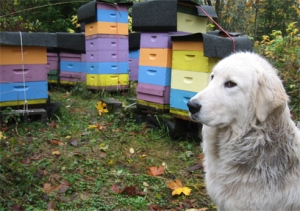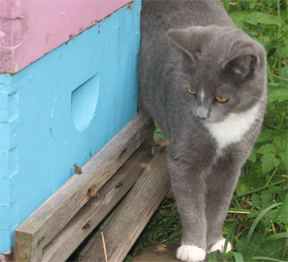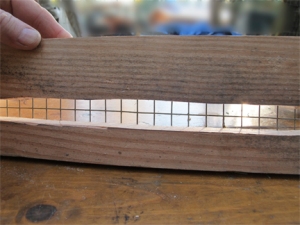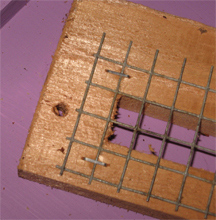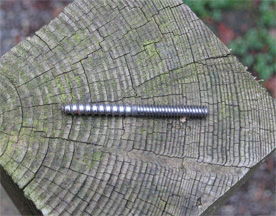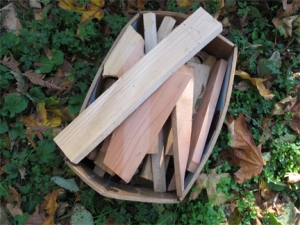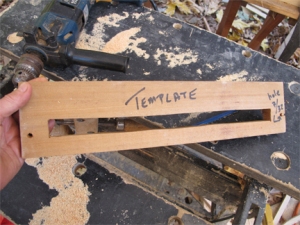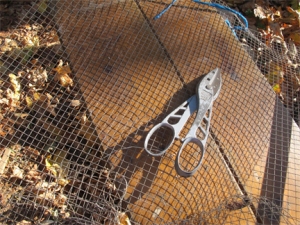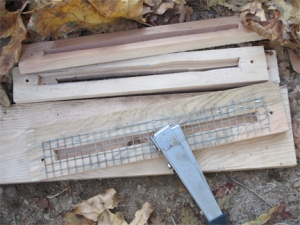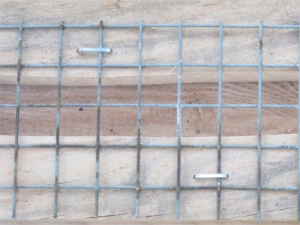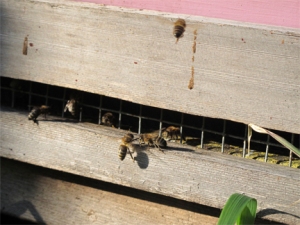More than half of my hives are in bee yards where bears are known to roam. These yards have either solar/electric bear fences, Livestock Guard Dogs, or very large dogs who live on the property (the latter two are different things, but the very large dogs seem to be working fine with hives in out-lying bee yards).
Mo the Maremma (Livestock Guard Dog)
Even though bears are all around us here, bears are not really a huge problem for me. The wildlife that stalks my hives is more pervasive, greater in number, and very, very persistent: mice. I admit it: they are cute; they are native, but I hate them.
Of Mice and Bees
When a mouse, or usually two, sets up home in a nice warm hive in the winter the hive will be dead by spring. The bees just cannot take being the commode for the furry intruders.
My farm cats patrol my hives, but not every bee yard has six resident cats. And even my mammalian mouse guards can’t be on patrol all the time.
Anubus checking the mouse guard
The answer is year-round, wood-and-wire mouse guards. Or that would be the answer if I ever got around to making enough mouse guards. I always seem to be playing catch-up in the construction of these. For this reason, late October found me scrambling to make more mouse guards to put on a number of the hives.
Brookfield Farm Mouse Guards
My mouse guards are wood and ½ inch hardware cloth (square wire mesh).
The openings are the entire width of the hive entrance. They vary in height, but are always tall enough to cover the space between bottom screen and the first box.
Wire Down the Center
The ½ inch openings are somewhat reduced in height because I place the centerline of the mesh across the center of the mouse guard opening. I have never had a mouse make it though this opening.
The mouse guards are held in place by two hanger bolts screwed into either side of the hive entrance. Each mouse guard has a hole in on each side, which slide over these bolts.
stapled wire & mounting hole
Hanger Bolt
No mouse has ever been able to pull one of these off the front of a hive. But the mouse guards can be removed during spring-cleaning, then easily replaced.
Construction Material Considerations
I am lucky to be married to a fellow who makes furniture . This means we have an ample supply of off-cuts of wood that can be cut down to make the frame.
Off-Cuts to become Mouse Guards
The ½ inch hardware cloth was a fortuitous coincidence. Brookfield Farm was once a fiber farm (Shetland and Jacob sheep, cashmere goats). I used to have a ½ inch-skirting table for the wool. When I was experimenting with different typed of mouse guards years ago, I looked at the disused skirting table and thought: hey I’ll use that up. It has worked well.
I use a template for the mouse guards
The template
Then my husband produces the wooden ware.
Mouseguards Cut But Not Wired
Then I cut the wire
Tin Snips & 1/2 inch wire
With proper supervision
The Supervisor (and livestock guard dog)
The wire is then stapled to the woodenware with a tool designed to staple house wrap to buildings.
Staple Tool and Frames
Simply Stapled
Once finished, they are mounted on the hives.
Easy Passage For Bees
Fall Falls Fast
The design works. I’ve got the materials. I just never seem to have the time. So here I am in late October making the last mouse guards. Hopefully I’ll get them on before any mice move in. I would hate to trap the little furry “darlings” in the hive. If I do, I hope the bees win the “war”
The rest of the fall chores are just about done. The feeders are being pulled off the hives this week to be replaced by a piece of insulation. The rain hats will be tied down. Future blog topics, eh? Then the long winter of trying to make wooden ware for the bees begins – this time mouse guards will move further up the list.
That’s the news from Brookfield Farm Bees And Honey, in Maple Falls, Washington. How did your fall, or spring, preparations fare? And what is your solution to dealing with those ever so cute, but horrid, mice?

